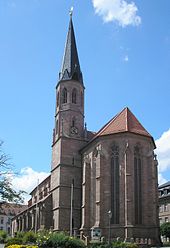St. Martin (Heilbad Heiligenstadt)
The former collegiate church of St. Martin in Heiligenstadt in Eichsfeld , Thuringia, is the main Protestant church of the city and region. It belongs to the Mühlhausen parish of the Evangelical Church in Central Germany .
history
The hill of St. Martin is where the oldest church was founded in Eichsfeld. According to legendary tradition, it was carried out by the Frankish king Dagobert I and was furnished with relics of the Mainz martyr bishop Aureus and his deacon Justinus. These patrons , together with Sergius and Bacchus , who were added in the 9th century , are the saints in the name of the Heiligenstadt settlement that was built near the church. At the same time, they testify to the close connection to the Archdiocese of Mainz and belonging to Kurmainz , which lasted until the end of the 18th century. It shows itself even more clearly in the change to St. Martin's patronage , which took place as early as the 8th century.
The first hall church was replaced by a pre-Romanesque basilica with a cross plan in the middle of the 9th century .
960 the archbishop of Mainz founded Wilhelm one in St. Martin Augustinian canons - pin . In the period that followed, the monastery and church gained supraregional importance. Excavation results from the 1990s suggest an imperial palace . As archdeacon , St. Martin was the mother church for eight parishes, including St. Mary in Heiligenstadt, and seven monasteries.
Around 1276, the reconstruction and new construction of the church began with the convent building and cloister in the Gothic style , which was completed around 1450.
The Reformation sat down because of the political affiliation of the Eichsfeld to Kurmainz in Heiligenstadt not permanently through. When the miraculous image of Our Lady of Sorrows came to St. Martin during the Thirty Years War (since 1803 in St. Marien), the collegiate church also became a place of pilgrimage .
The Reichsdeputationshauptschluss 1803 brought the end of the clerical principalities and most of the monasteries and monasteries. The Congress of Vienna allocated the lower field to the Kingdom of Hanover and the upper field to Prussia . The Martinsstift was dissolved. The church was handed over to the Protestant community by the Prussian government. Most of the equipment that was not used for the Protestant service ended up in Catholic churches in the city and the surrounding area.
1862–1866 St. Martin was restored in the spirit of historicism , with further pieces of equipment being removed.
Architecture and equipment
Apart from a few neo-Gothic changes, the Martinskirche has been preserved intact in its high-Gothic appearance. It is a three-aisled basilica with a ribbed vault . The two-bay choir with a polygonal finish continues the central nave without a break. At the transition between the nave and the choir, a half-bar is attached to the south, which supports the octagonal tower with a pointed helmet . The rich sculptural decoration of the portals shows the saints of Martinskirche and a coronation of Mary .
During the last restoration, the interior was left without color, so that the richly structured architecture works by itself. The colored windows, especially the rosette of the west facade, let the red sandstone appear in changing light.
The carved wooden pulpit and the three-part sandstone altarpiece , the images of which show Christ before Thomas in the middle and the four evangelists on the outside, date from the 19th century .
organ
The first organ in St. Martin was built in 1831 by Johann Friedrich Schulze from Paulinzella. In 1949 the instrument was changed in the course of the organ movement. The new, neo-baroque organ was built in 1972 by the Gotha organ builder Rudolf Böhm . The slider chests -instrument has 27 registers on two manuals and pedal . The playing and stop actions are mechanical.
The disposition of the current organ:
|
|
|
||||||||||||||||||||||||||||||||||||||||||||||||||||||||||||||||||
- Coupling : II / I, I / P, II / P
Disposition of the Schulze organ from 1831:
|
|
|
||||||||||||||||||||||||||||||||||||||||||||||||||||||||||||||
- Coupling : II / I, I / P, II / P
Disposition of the organ after the renovation in 1949:
|
|
|
||||||||||||||||||||||||||||||||||||||||||||||||||||||||||||||||
- Coupling : II / I, I / P, II / P
literature
- Elmar Golland: The whereabouts of the inventory of St. Martin's Church. In: Müller, Thomas T. (ed.): The St. Martins Church in Heiligenstadt. Heiligenstadt Writings Volume 2, Heiligenstadt 2003, pp. 91-101
- Martin Herche: The Evangelical Church of St. Martin - mother church of Eichsfeld. In: Heimat Thüringen 7 (2000), ed. from Heimatbund Thuringia, ISSN 0946-4697, pp. 13-15
Web links
Individual evidence
- ↑ More information about the organ ( memento of the original from October 25, 2012 in the Internet Archive ) Info: The archive link was automatically inserted and not yet checked. Please check the original and archive link according to the instructions and then remove this notice.
Coordinates: 51 ° 22 ′ 39.5 ″ N , 10 ° 7 ′ 53.3 ″ E



